Table of Contents
If you own a tube-based guitar, bass, or even a Hi-fi audio amplifier, chances are you will find a 12AX7 being used in them. Maybe even a few of them.
The 12AX7 is the first choice for tube amplifiers. This is because of its high gain and relatively low noise characteristics. But which are the best 12AX7 tubes, and what should you pick?
And even though it’s as popular as it is, most people know very little about them. Even changing one can be a nerve-racking experience.
So I’m going to change all that with this ultimate guide! I suggest you bookmark this article, so you can return to it when you need to know about the 12AX7!
Best 12AX7 Tubes
Each manufacturer produces a 12AX7 that is its own, and each one has strengths and weaknesses. Some are darker sounding while others are bright.
Some are noisy while others are not. So I have created a comparison chart below with some reviews on what I feel these tube brands bring to the table.
I chose these versions because they are some of the best 12AX7/ECC83 tubes on the market. They are still affordable and easy to get. You will find recommendations for both instrument amplifiers and HIFI applications.
The 3 main things I chose to evaluate are microphonics, noise, and frequency response.
These are some main things you would want out of a 12AX7. So I have given each tube a rating for their strengths and weaknesses. The higher the number, the better the tube is in this area.
The tests conducted were done using many amplifiers. Each capable of different music types. These are the amplifiers used:
- Revv Generator Mk2: high gain and clean tones.
- Vox AC30: crunch tones.
- Marshall JCM 800: vintage crunch and clean sounds.
- Mesa Boogie Prodigy: bass amp.
- BoyuuRange Reisong A12: HIFI amplifier.
1. JJ 12AX7/ECC83S (Best Value)
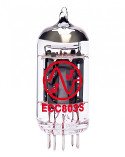
The JJ ECC83 is a very popular 12AX7 among guitar players and musicians. This tube is well-balanced and is relatively low in noise. JJ has become a very popular and well-known brand over the last few decades.
As they make durable tubes with good longevity. They are capable of taking a beating, standing up to aggressive touring and gigging.
This model is warmer sounding than other 12AX7 and is great if you are looking for a darker tone. If you have a harsh or bright sound, this version will tame that harshness.
The low microphonics of this tube and gain structure make this a perfect choice. Especially for guitar amps in the more aggressive realms.
Score
JJ 12AX7 Score
Overall
-
Microphonics
-
White Noise
-
Response
-
Durability
Microphonics and Noise
With the JJ 12AX7 tubes that I received, the level of microphonics were low. Only a couple of them had a level of microphonics that I might be a bit concerned about. But it was only apparent when they were used in the first stage of an amplifier.
This is because the noise floor is very low. When they were used in a part of the circuit with higher levels of amplification already, the microphonic nature had no impact. They have a decent level of white noise. But this is only really apparent in high-gain guitar amps.
Performance
When testing these tubes against other brands, I found them to perform good. JJ has improved their performance over the years.
At one point, they were very unreliable. But today they are quite good. The noise level is about average. Some can be more noisy than others for whatever reason.
From a sound perspective, they are good tubes for certain application. My opinion is that they are best for instrument amplifiers.
The sound you get is excellent for guitar amps that have a need for a balanced tone. They do have a darker tone to them, but are still bright enough to be appealing.
Where It Excels
The JJ 12AX7/ECC83 tube is recommended for high-gain amplifiers. Those that are focused on warmer rhythm tones and aggressive sounds. Music like:
- Metal.
- Hard rock.
- Rock.
- Bass Amps.
But they are also capable of delivering superb clean sounds. They can also work for blues, jazz, and classic rock tones. For bass amps, this is also a great choice as they pack a punch.
This JJ ECC83S will work better in instrument amplifiers. It’s not recommended for HIFI applications.
2. Genalex Gold Lion 12AX7 (Top Performer)
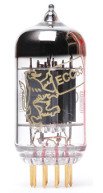
The Genalex Gold Lion 12AX7 is smooth and is an incredible tube. It will increase the performance and definition of your amplifier.
This tube has a very broad mid-range that is pleasing to the ear, but isn’t boxy or flat. The detail in the note response is rich, tight, and articulate. Which is everything you could need or want.
Score
Genalex 12AX7 Score
Overall
-
Microphonics
-
White Noise
-
Response
-
Durability
Microphonics and Noise
These are high quality tubes. Right away I noticed that the noise was much lower than the other tubes. This is perfect for the first stage of an amplifier where the noise floor is low.
None of the Gold Lion tubes I received were microphonic. When tapped on, the sound was a low thud, no ringing at all. I like these tubes a lot, but they are expensive!
Performance
The highs and lows are balanced, giving this tube a very full dynamic sound. This is considered the best 12AX7 in production and the change is noticeable!
They have a very present punch in the lower midrange. But the highs are also silky smooth. This tube can be used in any position or stage of your amplifier.
Where It Excels
The triodes inside this envelope are balanced to within 15% of each other. This means they also make a great phase inverter or buffer tube. Effect loops will also benefit from this one.
The Genelex Gold Lion is the perfect tube for:
- Rhythm.
- Leads.
- Clean tones.
- Bass Amps.
- HiFi Amplifiers.
I recommend the Genalex Gold Lion for both instrument amplifiers and HIFI applications.
PSVANE 12AX7 (Premium)

The PSVANE 12AX7 has been sought after by HIFI enthusiasts. This is because the tube provides high quality in most areas. Even the pins are lined up perfectly well. So well that they almost just fall into the sockets!
Score
PSVANE 12AX7 Score
Overall
-
Microphonics
-
White Noise
-
Response
-
Durability
Performance
The PSVANE 12AX7-T is an amazing tube for musical instruments and HIFI Applications. This version has a full body, deep bass, and pristine highs. Compared to others, it has a noticeable high-end performance. The Psvane performed better and is richer, thicker, and more complex.
For musical instrument amplifiers, this tube was a no brainer. The low end is present, but not overly muddy. When saturated, it was thick and fast enough to fill the room in a pleasing way. The top end was not overly aggressive, but rounded and musical.
Where It Excels
Running any type of HI-FI equipment that is medium-grade quality or higher? Then you will enjoy these tubes. The experience in both music and movies is well worth the money. They are also very quiet.
I recommend the PSVANE 12AX7-S for all applications.
Changing tubes? You may also want to consider these best 6L6 power tubes!
JJ ECC803S
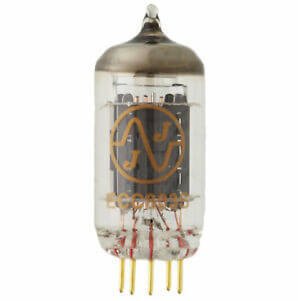
The JJ ECC803/12AX7 is a long plate tube based loosely around the ECC83S. I wanted to include this model in my list because it’s quite different from the 83S.
Especially in the high-end response, which had a bit to do with the gold pins. The low-end and mid-range are also different. It’s very full and almost sounds like a blanket was removed from a speaker.
Score
JJ ECC803S Score
Overall
-
Microphonics
-
White Noise
-
Response
-
Durability
Microphonics and Noise
One thing with long plates is they are known to be a bit noisier, but I didn’t experience that with this model. It wasn’t extremely quiet, but about average with a regular JJ.
The microphonics were also about the same. Two out of five had some sort of microphonics. But again, only in the first stage. If I were to tap on the tube, I could hear a slight ringing. But I did find it acceptable.
Performance
As I played it more, over time it seemed to continue to get sweeter sounding. It’s a wonderful tube and is well-balanced and musical. Any amplifier can benefit from this one, and it will fit many forms of music.
Clean tones were exceptional and vibrant. Being as full as it was, I also found the bass amp to respond great with this tube. I think I liked it more in vintage style guitar amps for the fullness it provides. But in high gain amps, I didn’t notice a huge difference.
Where It Excels
Unlike the 83S, I found this to be a better candidate for HIFI audio and would complement a good system. It can also be used for instrument amplifiers, but just be careful of microphonics.
This JJ ECC803S will work great in all types of instrument amplifiers. Plus HIFI applications.
Tung-Sol 12AX7
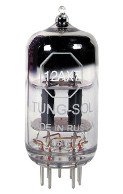
The Tung-Sol version is another popular model. This tube is very musical and rich in harmonics. The highs are smooth rather than harsh yet pronounced. Tung-sol is now owned by Electro-Harmonix.
They are popular in the amp world. This is because of the durable and very musical products they make. These tubes are trusted and relied on by many musicians, from hobby to pro.
Score
Tung-Sol 12AX7 Score
Overall
-
Microphonics
-
White Noise
-
Response
-
Durability
Microphonics and Noise
The low microphonics and robust build make them an amazing choice for many types of music. They work great in any position in your amp because of their low noise.
They are made with a short plate. This design lowers noise, making this tube perfect for the input stage in an amp.
Performance
This tube has the ability to tame high-end harshness, but isn’t dark or muddy. Good sounding with decent drive. Its bright and sparkly sound is perfect for not only clean tones, but is good for searing leads.
I found they had a slightly lower gain output. This provided a better dynamic experience. When you play lightly, they clean up more.
But when you dig in, they can also get aggressive. They seem to be easier to control. This was a pretty good performance for what I was looking for!
Where It Excels
The Tung-Sol 12AX7 is a very good tube, and I recommend it for:
- High gain Rhythm.
- Leads.
- Clean tones.
- Bass Amps.
They will fit any form of music because of their clarity and balanced sounds.
While I would recommend the Tung-sol more for instrument amplifiers. They do a decent job in HIFI applications also.
Mullard 12AX7
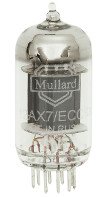
The Mullard 12AX7 has a long history. It has earned a reputation in the NOS hall of fame. Today, the reissue is just as good and a perfect tube for clean or vintage sounds.
Because it has a more gritty sound to it when driven into saturation, it serves a better role in the crunch tones. Depending on your amplifier, it may work perfectly for high gain. But I found it favored classic stuff more.
Score
Mullard 12AX7 Score
Overall
-
Microphonics
-
White Noise
-
Response
-
Durability
Microphonics and Noise
Good build quality helps keep noise and microphonics very low. This makes it a nice tube for any position in your amp. The low noise is due to a smaller plate and robust design.
There were no clicks or pops, and the white noise was low. I also found that there were no microphonics in any of the Mullard’s I received.
Performance
It has a very warm tone and crisp top end, perfect for low gain feel and leads. When you dig in, the response is everything you could ask for.
But it’s important to know that the sound is flat. There is very little tone coloring done by the tube. To me, this makes it perfect for more classic sounds. Also, excellent for HIFI systems!
Where It Excels
Bass amplifiers will make great use of this tube, as it provides a full sound with a deep low end. And because it’s so well-rounded, it also works like a champ in HI-FI applications.
It will be optimal in genres like:
- Blues.
- Jazz.
- Classic Rock.
- Vintage sounds.
- Bass amps.
- Hifi.
I recommend the Mullard 12AX7 for low gain tones, bass amplifiers, and HIFI applications.
Electro-Harmonix 12AX7

The Electro-Harmonix 12AX7EH is another great choice. It’s one that doesn’t get the recognition it deserves. This tube is one that you will find comes in a lot of amplifiers right from the factory.
This is because of its sturdy build quality and full-bodied sound. Not only that, but you can also find them in a lot of guitar pedals, as they work so well in many applications.
Score
Electro-Harmonix 12AX7 Score
Overall
-
Microphonics
-
White Noise
-
Response
-
Durability
Microphonics and Noise
The lack of noise and microphonics was appreciated. Especially when upgrading from lower-quality tubes. It seems Electro-Harmonix has upgraded this tube to be a lot quieter.
I remember it being noisier in the past. But this time, it had better microphonics and noise. I did find it to be a bit noisier than some of the other options though.
Frequency Response
The articulation in this model was frequency wide. It kept itself together brilliantly. The bass was rounded but not mushy, and the top-end response was right on point.
It was neither sharp nor dull and was pleasing to the ear. It was very flexible between the different amplifiers, too.
Some were a bit more bass heavy than others. But this tube adapted to the different voicing and circuits perfectly. I did enjoy it more in the higher gain setting, but vintage amps sounded good too.
Where It Excels
This is a good tube for:
- Metal.
- Rock.
- Classic.
- Blues.
- Jazz.
- Bass amps.
- HiFi.
The Electro Harmonix 12AX7 is great in both instrument amplifiers and HIFI applications.
Sovtek 12AX7
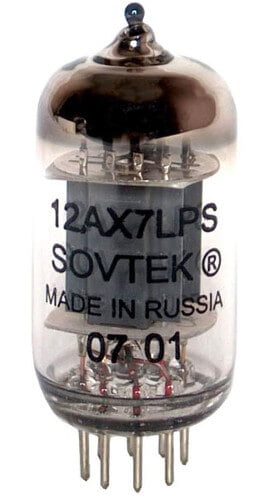
Another awesome tube made to breathe life back into the dullest of amplifiers! The Sovtek 12AX7LPS is a great-sounding tube with low noise and microphonics. Its break-up character is very pleasing. The chewy crunch tones were rich with articulate harmonics.
Score
Sovtek 12AX7 Score
Overall
-
Microphonics
-
White Noise
-
Response
-
Durability
Microphonics and Noise
The Sovtek tubes are known to be low on microphonics. And the batch I received were perfect! There were no microphonic tubes at all. I was rewarded with a deep, low thud sound when tapping on them. Just the way I like it! As for noise, there was a bit. The white background noise under high gain applications was present. Not bad, but noticeable.
Frequency Response
High gain tones were quite good with full, rich sound and response. They lean towards the warmer side of the spectrum, but the highs were still present and clear. They do color the tone a bit, but do so in a very smooth way. There was nothing harsh about the sound, it was dynamic and rich.
Where It Excels
For HIFI, this was a good fit, very smooth and full, with no odd noises or funny responses. Bass amplifiers will benefit from this model because of its warmer mid-range punch.
The type of music i would suggest for this tube type:
- Rock.
- Classic.
- Jazz.
- Country.
- Bass amps.
The Sovtek 12AX7LPS is a good choice for both instrument amplifiers and HIFI applications.
Svetlana 12AX7
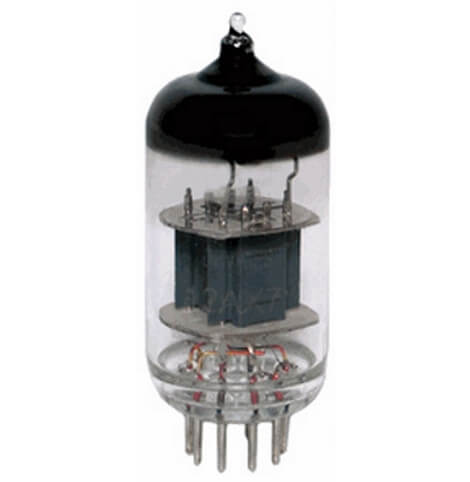
The Svetlana 12AX7 is a tube designed after a New Old Stock favorite. This model is well received by those who like the old RCA’s because of its smoother frequency output.
Score
Svetlana 12AX7 Score
Overall
-
Microphonic
-
White Noise
-
Response
-
Durability
Performance
This tube has a nice bass response, being quite full in the lows but not overbearing. The mid-range is smooth and very present, which was perfect for lower gain crunch tones. The top end was open without being too bright.
This tube is not harsh and doesn’t have the same gain output as some of our more metal-friendly selections. But this makes it perfect for softer tones and bass amps. Upon saturation, the structure was not overly gritty or grainy. It was a very articulate and musical experience.
Where It Excels
For HI-FI applications, this tube is a real gem. It’s balanced, refined, and less bright than some other models. This makes it great for this application. It is well worth a try and very affordable.
I suggest this tube type for:
- Rock.
- Classic rock.
- Country.
- Jazz.
- Blues.
- Bass Amps.
- HiFi Amplifiers.
The Svetlana 12AX7 is a good choice for instrument amplifiers and HIFI applications.
Groove Tube ECC83

The Groove Tube 12AX7 is a Fender-branded model, and it sings. This one has a stronger output, putting more bite into your high-gain tones. Its ability to add beef to a saturated tone is over the top. This is the type that opens up your sound by providing a good presence across all frequencies.
Score
Groove Tube 12AX7 Score
Overall
-
Microphonics
-
White Noise
-
Response
-
Durability
Performance
Clean sounds were very rich, and the chime provided a nice experience overall. The crunch tones were full of life and very detailed. Compared to other tubes, this one felt a bit more aggressive. The build quality is excellent!
But because of the added aggression, there was a bit more noise compared to other tubes. A couple of the ones I tried had a slight ring to them when saturated, but nothing crazy.
Where It Excels
This tube has that Marshall bite! Yet it has a full-bodied mid-range and solid low end. Perfect for both rhythm and leads. Because of the full spectrum of sounds, bass amps will come to life with this model.
This is a good12AX7 for :
- Metal.
- Hard Rock.
- Grunge.
- Medium gain.
- Clean tones.
I recommend the Groove Tube 12AX7C for instrument amplifiers. There are better choices for HIFI.
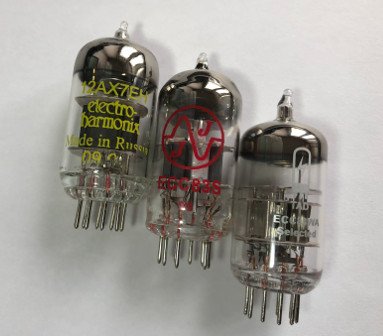
What Is A 12AX7?
The 12AX7 is a 9-pin dual triode, meaning it has 2 sides or amplifiers in one glass envelope or tube. It’s a small signal high-gain amplifier. It can take a small input signal and amplify it a lot.
This is especially handy in instrument amplifiers. The signal from instruments is very low. Normally in the millivolt range. Each triode or amplifier inside the tube has 3 pins. They control the amplifier and a shared heater element.
This heater element stimulates electrons inside. It’s seen by a faint orange-like glow. The 12AX7 is a part of a large family of twin triode vacuum tubes, each with its own characteristics.
They span a wide range of gain, ruggedness, microphonics, stability, and even lifespan. But the 12AX7 is the most commonly used type of them all, with over 2 million being produced annually.
How to Choose the Right 12AX7
Given their popularity, it’s likely that your amplifier contains one or more 12AX7 tubes. These tubes are commonly used in guitar, bass, and HIFI amplifiers, as well as pedals for their desirable tone.
However, how do you determine which 12AX7 tube is best suited for your sound and setup?
Choosing a 12AX7 can be difficult. Especially with the many options available. And each one has its own strengths and weaknesses.
So I recommend carefully reading our reviews. Then select the 12AX7 that best aligns with your musical style. For high-gain amplifiers, experimenting with different types. Putting them in various positions may also be worthwhile.
Some tubes are better in circuits designed for crunch sounds. So you may want to lean towards some of those models that do it well.
As long as you select a tube that complements your desired sound, you can’t go wrong. I have reviewed and listed some of the best 12AX7 tube models currently available.
And many of which are affordably priced. Experiment with multiple tubes. This can also be a great way to discover the sounds only they can produce.
Technical Information
Choosing the right tubes also means knowing it’s technical information. Below you will find some of the more important information that you should know about the 12AX7 tube.
Specification And Max Ratings
The label 12AX7 is a series of designates that describe what the tube is capable of and how it is to be used. It’s not simply just a model number. For example, the 12 indicates the required heater voltage. The “A” indicates it’s an amplifying device.
The X indicates its electrical characteristics. While the 7 indicates the number of active pins.
- Filament Voltage: 6.3-12 V.
- Filament Current: 300-150 mA.
- Plate Voltage (max): 330 V.
- Plate Current (max): 6 mA.
- Max Plate Dissipation: 1.1W.
- Lifespan: 10,000 Hrs.
Pin Out
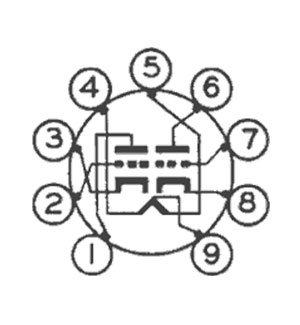
- Plate 2.
- Grid 2.
- Cathode 2.
- Filament 2.
- Filament 1.
- Plate 1.
- Grid 1.
- Cathode 1.
- Shared Filament.
Datasheets
If you’re looking for the datasheet on the 12AX7 tube, we’ve provided links to a few helpful resources below.
- Click Here for datasheets to many different tubes including 12AX7.
- Click here for the JJ ECC83 (12AX7) Datasheet.
- Click here for the Tungsol 12AX7 datasheet.
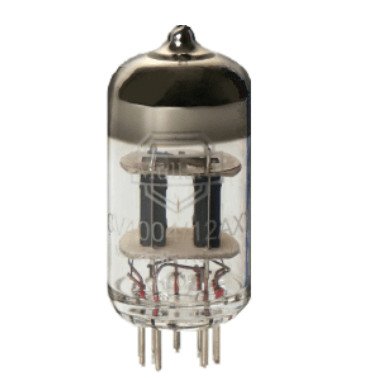
Different 12AX7 Names And Labels
The 12AX7 tube also comes in a few different model names. This is because some have been tested for noise levels. And others are made in different countries. Here are a few common names you might find for this vacuum tube.
ECC83
If you have ever opened up your amplifier expecting to find a 12AX7 but found some ECC83s instead, fear not! There is actually no difference between them.
Except for the name and place of manufacture, they are compatible. The 12AX7 label is what was used when this type was manufactured in North America.
Today, there are no factories in North America making them anymore. But by request, manufacturers will label them as such. After all, the design is the same. The ECC83 is the label that was applied to this type by European manufacturers, yet it’s the same tube.
So if you ever find an ECC83, you can replace it with a 12AX7 and vice versa. They are the same tube type with just a different nomenclature, so go ahead and use that ECC83 in place of a 12AX7!
7025
The 7025 is a tube that was developed in the 1960s as an upgraded version of the 12AX7. It was designed to be quieter and more robust than the standard tubes of that time. And as a result, it quickly became known as the “low noise” version of the 12AX7.
Compared to the standard 12AX7, the 7025 had several advantages. First, it was less susceptible to microphonics. This prevents unwanted noise and distortion in audio circuits. It also had a more robust construction. Which made it less likely to break or fail during use.
Over time, manufacturers of the 12AX7 began to adopt the design of the 7025. This led to a widespread improvement in the quality of the 12AX7 tubes available.
However, some manufacturers still produce versions of the 7025 today. By using higher-quality metals and other materials to further enhance their performance.
5751
The 5751 version of the 12AX7 was created as a military spec. This tube was given extra support internally and had matched triode sections.
The amount of gain produced by a 5751 is also lower than the 12AX7. Your standard model has a gain factor of 100 whereas the 5751 is 70.
Some people refer to the 5751 as being a 12AT7 because it too has a gain factor of 70. But this simply is not the case, as the plate resistance of a 5751 is the same as a 12AX7. You can use a 5751 in its place, but keep in mind it will produce lower gain.
So if you want to tame an amplifier with too much gain, this is the tube you want to use in select spots of a preamp.
You can also use this tube in the position of the phase inverter to produce less power from an amplifier.
12AX7 “A” and “B”
The 12AX7-A and B are two tubes that are identical in nearly every way. You may have come across these two labels in your search and were curious about the differences.
They are made in the same batches and are pretty much an identical tube. But some of them come out producing high gain.
The 12AX7-A is a higher-gain version of its counterpart. For all intent and purpose, the “B” version is simply a screened tube selected for its high gain and low noise. The ones that had higher gain and were noisier may have simply been named 12AX7-A.
Mesa Boogie and Peavey use 12AX7-A labeled versions. This is because of the higher gain, but this comes at a price of a noisier output sometimes. But if you want a gain monster for an amplifier and are not worried about noise, the 12AX7-A is your animal.
If you want high gain and a quieter, even softer tube sound, the “B” version is your best bet.
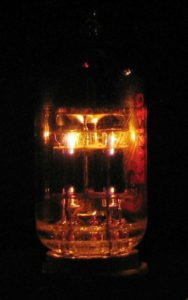
FAQ
Which 12AX7 Sounds Best?
I prefer the Genalex gold lion tubes because they are well-rounded in frequency response. They are also low in noise and robust. But they are expensive.
You might prefer a different sound than what I like, however. And so, in order to truly know what sounds best to you, try a few different variations.
Are all 12AX7 tubes the same?
Electrically speaking, yes, they are the same with an amplification factor of 100. They are interchangeable as long as the design calls for a 12AX7 tube. But they are different when it comes to sound quality. Some sound darker than others and have different frequency response.
There are even some that output more gain than others as well. Try and few different brands to see what you prefer.
My 12AX7 Flashes At Start-Up
A flash from a 12AX7 is normal at start-up and is nothing to worry about. Over the course of time, this may even go away.
New tubes will often do this for the first few start-ups. There may be some gasses that remain from manufacturing. But I have found that it stops flashing after a few uses.
If you see your power tubes flash at start-up, this is not normal! If this happens, turn your amp off and get it serviced. Flashing is bad and could cause damage to the amp.
Can you mix 12AX7 tubes?
Yes you can! Mixing 12AX7 tubes is a great way to find the ones that work best in the many different positions of your amplifier. Because they operate the same electrically, mixing the tubes will allow you to find the best sonic performance for your tone.
Personally, I like to use JJ 12AX7 tubes in certain positions because they are darker sounding. But then for others, l like a brighter sounding tube like a Shuguang or PSvane.
What is the hottest 12AX7?
The hottest tube is the Shuguang 12AX7A. This tube is bright, but also has a very high output when compared to the many others.
It’s so high that even some metal amps don’t sound good when using it because it drives them too hard. But in others, it can be exactly what you are looking for!

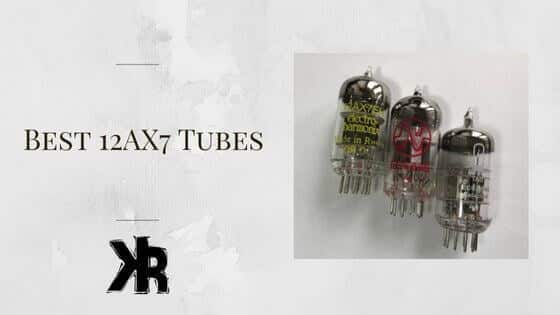
Very clear and comprehensive explanation of 12AX7 tubes. Really appreciate such a resource. The guitar world needs you. BTW put Gold Lions in a Marshall TSL60 and it became a beautiful blues amp. Worth the $.